The Competitiveness of Regional Urban System in Hubei Province of China
Abstract
:1. Introduction
2. Materials and Methods
2.1. Study Area
2.2. Methods
2.2.1. Evaluation Index System of Urban Competitiveness
2.2.2. Comprehensive Index of Entropy Weight of Urban Competitiveness
- Standardization of decision matrix.
- 2.
- 3.
- Determine the weight of each indicator
- 4.
- Calculate the comprehensive evaluation score
3. Results
3.1. The Entropy Weight of the Index
3.2. The Information Entropy of the First-Level Index
3.3. Evaluation and Analysis of Urban Comprehensive Competitiveness
4. Discussion
4.1. Index System of Urban Competitiveness and the Entropy Weights of Indicators
4.2. Urban Competitiveness
5. Conclusions
- Science, technology, and culture were the most important influencing factors of urban competitiveness. However, their weight showed a downward trend after 2013 from first to second place, and its distance from the first indicator was very small. Economic strength and open communication were also found to be very important. Additionally, their weights increased.
- The impact of the quality of life indicators on urban competitiveness increased rapidly. In particular, the growth weights of the per capita disposable income and consumption expenditure of permanent urban residents increased rapidly.
- Wuhan is the most competitive city in Hubei Province, and has an unshakable position. The competitiveness of Yichang and Xiangyang was strong, while the competitiveness of other places was weak or even extremely weak.
- The promotion of the adjustment of the industrial structure, as well as the steady and fast development of economy, and the promotion of cooperation between cities and the utilization of external funds. It is necessary to vigorously develop high-tech industries in order to enhance the competitiveness of science, technology, and culture.
- Cities should further improve their infrastructure and residents’ quality of life and attract more talents to settle in the city.
- Wuhan should play a leading role in driving the surrounding cities, as well as promoting the optimization and upgrading of industrial structure, so as to improve the development level of the whole region.
Author Contributions
Funding
Institutional Review Board Statement
Informed Consent Statement
Data Availability Statement
Conflicts of Interest
References
- Tao, L.; Zhang, T.; Gan, Y.; Qiu, Q.; Zhang, T. The Review of Urban Competitiveness Study in Domestic and Abroad. Urban Plan. Int. 2015, 30, 7–15. [Google Scholar]
- Xue-Qiang, X.U.; Cheng, Y.H. Spatial-temporal Changes of Urban Competitiveness in Urban Cluster of Pearl River Delta. Sci. Geogr. Sin. 2006, 26, 257–265. [Google Scholar]
- Nasi, G.; Choi, H.; Cucciniello, M.; Christensen, R.K. A systematic literature review of city competitiveness: A 30-year assessment and future agenda for public administration. Public Manag. Rev. 2022, 1–25. [Google Scholar] [CrossRef]
- Webster, D.; Muller, L. Urban Competitiveness Assessment in Developing Country Urban Regions: The Road Ahead; John Wiley & Sons, Inc.: Hoboken, NJ, USA, 2000. [Google Scholar]
- Kresl, P.; Ietri, D. Urban Competitiveness: Theory and Practice; Routledge, Taylor & Francis Group: London, UK; New York, NY, USA, 2014. [Google Scholar]
- Pengfei, N. China Urban Competitiveness: Theoretical Hypotesis and Empirical Test; Economic Press China: Beijing, China, 2001. [Google Scholar]
- Yu, T.; Gu, C. Influential Factors Combination and Competitive Advantages in Stages of Urban Competitiveness—Case Study of Suzhou in China. Chin. Geogr. Sci. 2004, 14, 202–208. [Google Scholar] [CrossRef]
- Florida, R. Cities and the Creative Class. City Community 2003, 2, 3–19. [Google Scholar] [CrossRef]
- Li, W.; Wang, R.; Miao, Y. Proactively Cultivate and Support the Creative Industry to Upgrade the Forces of Comprehensive Competitiveness of City in Shanghai. J. Soc. Sci. 2005, 1, 5–14. [Google Scholar]
- Guo, R.; Lin, Z. Creative City: Urban Competitiveness in knowledge Economy. In Proceedings of the First Cross-Strait Management Science Forum, Fuzhou, China, 31 October 2006; pp. 531–538. [Google Scholar]
- Liu, L. Influence of creative city construction on urban competitiveness and countermeasures. Contemp. Econ. 2012, 000(022), 6–7. [Google Scholar]
- Yuming, L. Report on the Comprehensive Competitiveness of Chinese Cities; China Morden Economics Publishing House: Beijing, China, 2009. [Google Scholar]
- Xu, K. On City Competition and City Competitive Power. Soc. Sci. Nanjing 2002, 1–6. [Google Scholar]
- Xu, K. Civilization and Prosperity: A Comparative Study of Urban Economic Development Environment between China and Foreign Countries; Southeast University Press: Nanjing, China, 2003. [Google Scholar]
- Han, X.J.; Yuan, Y.; Wang, X.B.; Yi-Jun, L.I. Research on the Evaluation of Resource-Based Cities’ Competitiveness Based on DEA. China Soft Sci. 2013, 6, 127–133. [Google Scholar]
- Sotarauta, M.; Linnamaa, R. The Finnish Multi-Level Policy-Making and the Quality of Local Development Policy Process: The Cases of Oulu and Seinänaapurit Sub-regions. Eur. Plan. Stud. 1998, 6, 505–523. [Google Scholar] [CrossRef] [Green Version]
- Sotarauta, M. Power and influence tactics in the promotion of regional development: An empirical analysis of the work of Finnish regional development officers. Geoforum 2009, 40, 895–905. [Google Scholar] [CrossRef] [Green Version]
- Nelson, R.R. National Innovation Systems: A Comparative Analysis; Oxford University Press: New York, NY, USA; London, UK, 1993. [Google Scholar]
- Creswell, J.W. Qualitative Inquiry and Research Design: Choosing among Five Approaches [with CD-ROM], 2nd ed.; SAGE Publications (CA): Thousand Oaks, CA, USA, 2006. [Google Scholar]
- Kumar, R.; Singh, S.; Bilga, P.S.; Jatin; Singh, J.; Singh, S.; Scutaru, M.L.; Pruncu, C.I. Revealing the benefits of entropy weights method for multi-objective optimization in machining operations: A critical review. J. Mater. Res. Technol. 2021, 10, 1471–1492. [Google Scholar] [CrossRef]
- Hongchang, S.; Yufeng, W. Rearch on Nanjing City Social Economic Aggregation and Industrial Wave. Soc. Sci. Nanjing 2002, 139–146. [Google Scholar]
- National Bureau of Statistics. China Statistical Yearbook-2010; China Statistics Press: Beijing, China, 2011.
- National Bureau of Statistics. China City Statistical Yearbook-2010; China Statistics Press: Beijing, China, 2011.
- Yang, D.; Yan, Y. The Establishment of Synthetical Estimation Variables System and Evaluation Methods. Value Eng. 2006, 9, 4–7. [Google Scholar]
- Schwab, K.A.; Martin, X. The Global Competitiveness Report 2014–2015. World Econ. Forum 2014, 1, 2–51. [Google Scholar]
- Guojie, Z.; Hongmei, Z. Study on evaluation index System of urban competitiveness based on Network Analytic hierarchy Process. Sci. Technol. Prog. Policy 2006, 23, 126–128. [Google Scholar]
- Li, L.; Han, B.-L.; Li, Z.-H.; Zhang, S.-W. Evaluation Index System for The Competitiveness of Innovative Cities and Its Empirical Application—Comparative Analysis Among Changsha City and Some Other Major Cities in The Eastern. Econ. Geogr. 2011, 31, 224–229. [Google Scholar]
- Qiang, W. Study and Quantitative Analysis on Index System of Urban Competitiveness Evaluation; Xiamen University: Xiamen, China, 2009. [Google Scholar]
- Yuemin, N.; Lizhi, T. The Concept and Indicator System of Urban Competitive Capacity. Urban Res. 2001, 3, 19–22. [Google Scholar]
- Zhang, C.; Ding, L.I.; Zhang, J.; Wei, X. Urban competitiveness evaluation and the evolvement in Northwest China. J. Arid. Land Resour. Environ. 2015, 29, 8–13. [Google Scholar]
- Yuan, Z.; Zheng, X.; Zhang, L.; Zhao, G. Urban Competitiveness Measurement of Chinese Cities Based on a Structural Equation Model. Sustainability 2017, 9, 666. [Google Scholar] [CrossRef] [Green Version]
- Yang, Q.; Lin, A.; Zhao, Z.; Zou, L.; Sun, C. Assessment of Urban Ecosystem Health Based on Entropy Weight Extension Decision Model in Urban Agglomeration. Sustainability 2016, 8, 869. [Google Scholar] [CrossRef] [Green Version]
- Peng, G. Comprehensive Evaluation of Regional Science and Education Competitiveness of Provinces and Cities in Western China; Northwestern University: Xi’an, China, 2007. [Google Scholar]
- Ji, W.; Liu, X. The optimization and improvement of the urban function of Gulou old urban district in Nanjing city. Jiangsu Build. Mater. 2017, 2, 43–48. [Google Scholar]
- Qi, Y.E. Survey of the Evaluation Indexes System of Region Competition Ability Around the World. J. Fujian Norm. Univ. (Philos. Soc. Sci. Ed.) 2008, 1, 91–96. [Google Scholar]
- Wang, F.; Liu, W.H. Research on Economic Competitiveness of the Cities—Evidence from Fujian province. Sci. Technol. Ind. 2011, 11, 106–110. [Google Scholar]
- Taoling, Z. Research on the Relationship between the Quality of Life for Urban Residents and Economic Development; Southwestern University of Finance and Economics: Chengdu, China, 2007. [Google Scholar]
- Zhou, M. The Research about Method of Sustainable Consumption System Measure. Syst. Eng. Theory Pract. 2003, 23, 25–31. [Google Scholar]
- Li, X.; Li, Y.; Gu, Z.; Yang, W. Competitive situation analysis of regional logistics development based on AHP and entropy weight. J. Southeast Univ. Nat. Sci. Ed. 2004, 34, 4. [Google Scholar]
- Zou, Z.; Sun, J.; Ren, G. Study and Application on the Entropy method for Determination of Weight of evaluating indicators in Fuzzy Synthetic Evaluation for Water Quality Assessment. J. Environ. Sci. 2005, 18, 1020–1023. [Google Scholar] [CrossRef]
- Sun, L.; Miao, C.; Yang, L. Ecological-economic efficiency evaluation of green technology innovation in strategic emerging industries based on entropy weighted TOPSIS method. Ecol. Indic. 2017, 73, 554–558. [Google Scholar] [CrossRef]
- Li, Y.; Sun, M.; Yuan, G.; Zhou, Q.; Liu, J. Study on Development Sustainability of Atmospheric Environment in Northeast China by Rough Set and Entropy Weight Method. Sustainability 2019, 11, 3793. [Google Scholar] [CrossRef] [Green Version]
- Zhang, X.; Wang, C.; Li, E.; Xu, C. Assessment Model of Ecoenvironmental Vulnerability Based on Improved Entropy Weight Method. Sci. World J. 2014, 2014, 797814. [Google Scholar] [CrossRef] [Green Version]
- Sun, B.; Yang, X.; Zhang, Y.; Chen, X. Evaluation of Water Use Efficiency of 31 Provinces and Municipalities in China Using Multi-Level Entropy Weight Method Synthesized Indexes and Data Envelopment Analysis. Sustainability 2019, 11, 4556. [Google Scholar] [CrossRef] [Green Version]
- Li, M.; Wang, J.; Chen, Y. Evaluation and Influencing Factors of Sustainable Development Capability of Agriculture in Countries along the Belt and Road Route. Sustainability 2019, 11, 2004. [Google Scholar] [CrossRef] [Green Version]
- Harper, S. Economic and social implications of aging societies. Science 2014, 346, 587–591. [Google Scholar] [CrossRef] [PubMed]
- Lee, H.-H.; Shin, K. Nonlinear effects of population aging on economic growth. Jpn. World Econ. 2019, 51, 100963. [Google Scholar] [CrossRef] [Green Version]
- Lu, H. Study on Promoting “Demographic Dividend” to “Talent Dividend”. Thinking 2011, 37, 243–244. [Google Scholar]
- Ren, C. Accelerate the Transformation of the “Demographic Dividend” to the “Talent Dividend”. Chin. Talent. 2012, 1, 1. [Google Scholar]
- Sáez, L.; Periáñez, I.; Heras-Saizarbitoria, I. Measuring urban competitiveness: Ranking European large urban zones. J. Place Manag. Dev. 2017, 10, 479–496. [Google Scholar] [CrossRef]
- Yang, J. Theoretical evolution of the role of infrastructure on economic growth. Econ. Rev. 2000, 6, 7–10. [Google Scholar]
- Hu, T.-S.; Pan, S.-C.; Lin, H.-P. Development, Innovation, and Circular Stimulation for a Knowledge-Based City: Key Thoughts. Energies 2021, 14, 7999. [Google Scholar] [CrossRef]
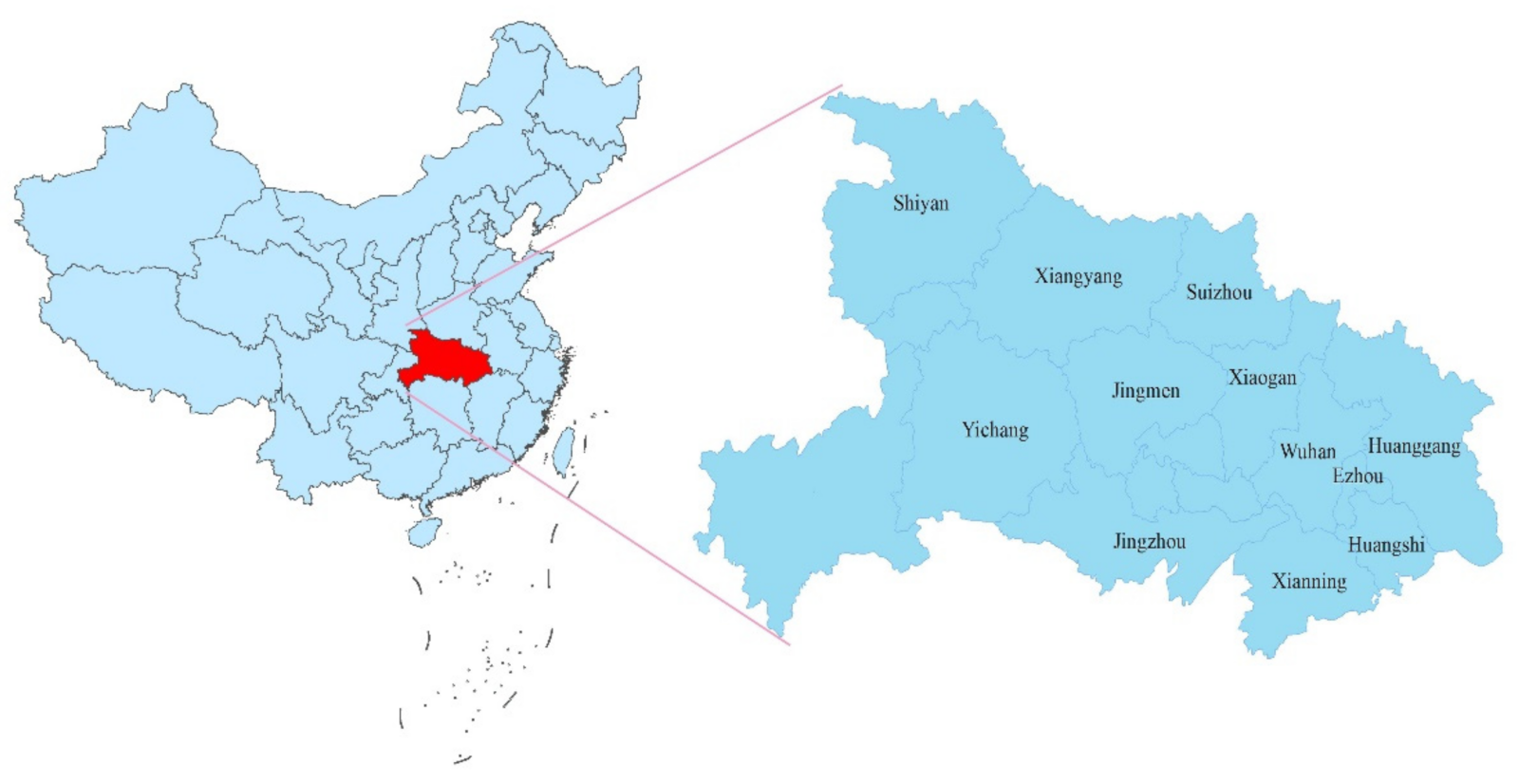
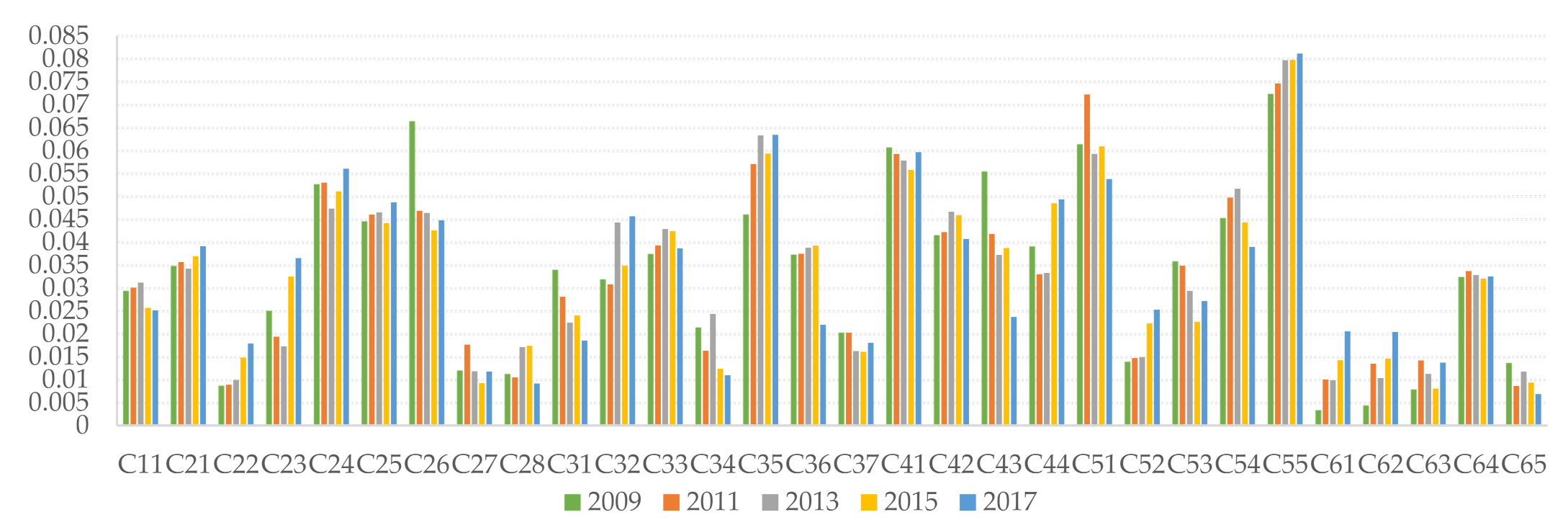
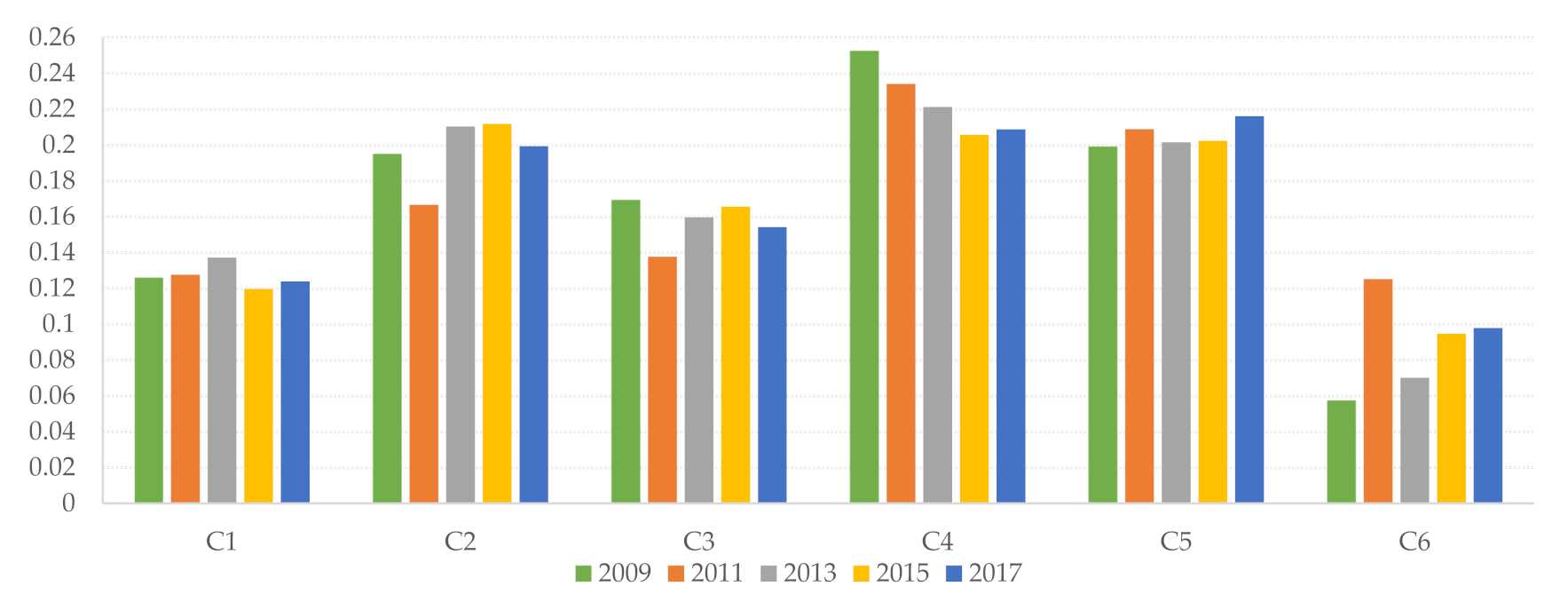
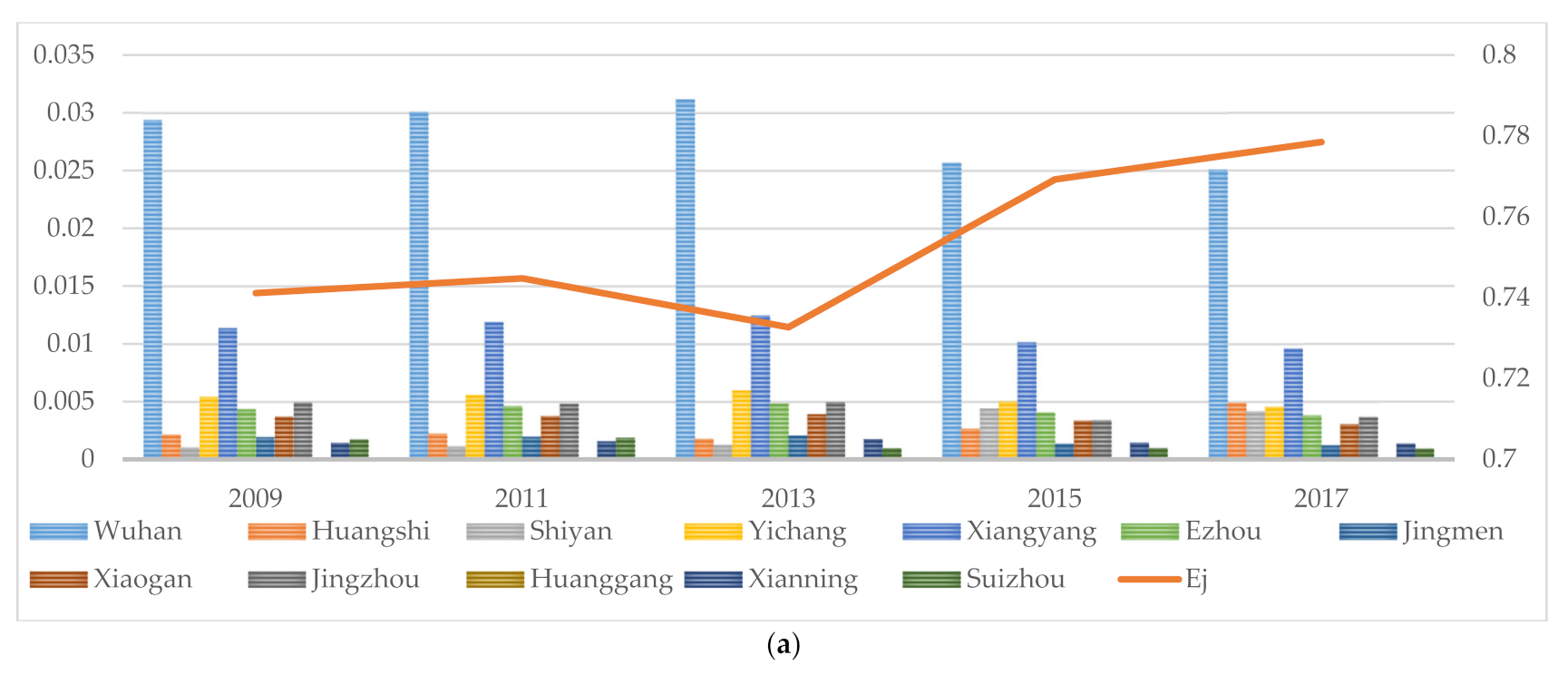
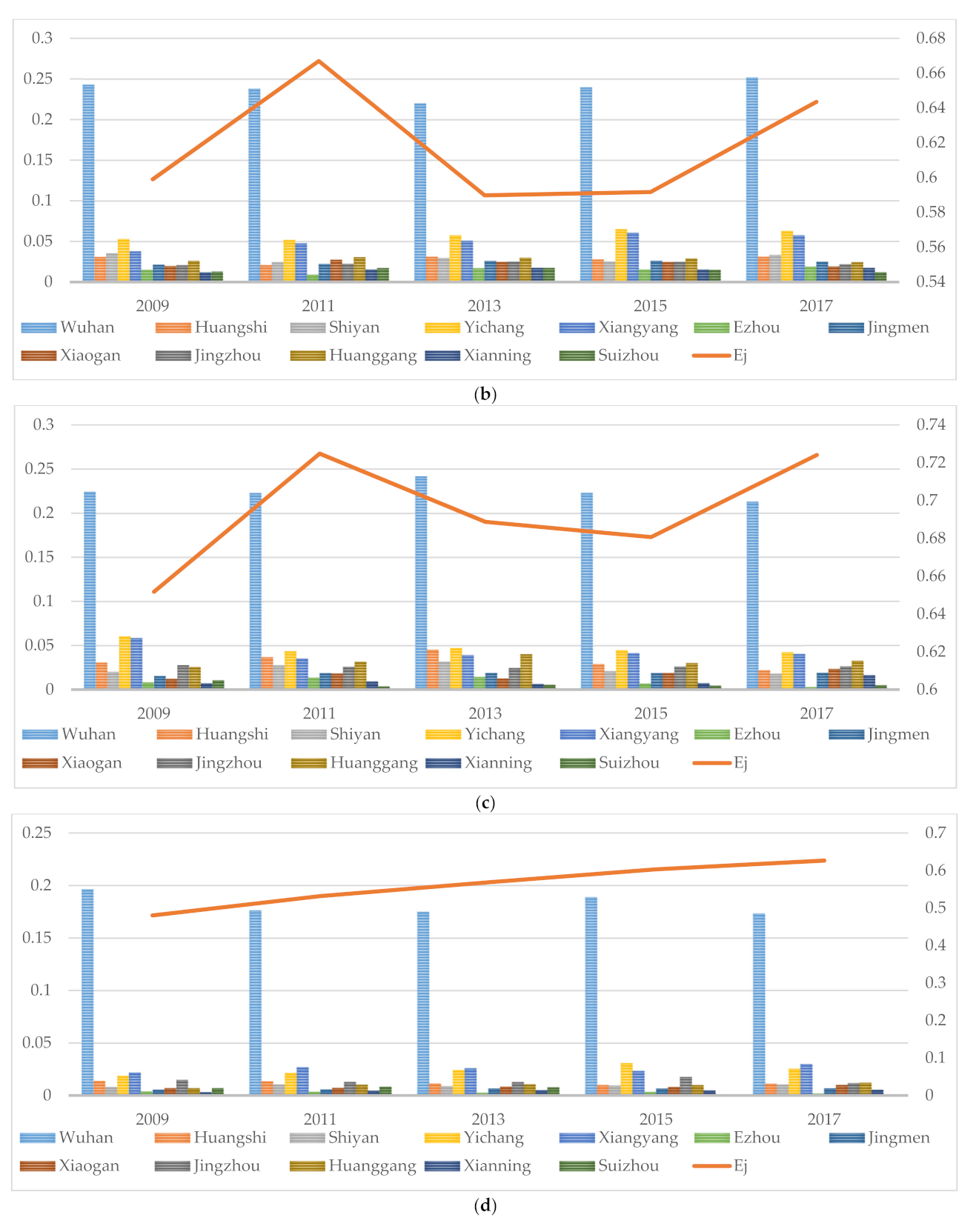

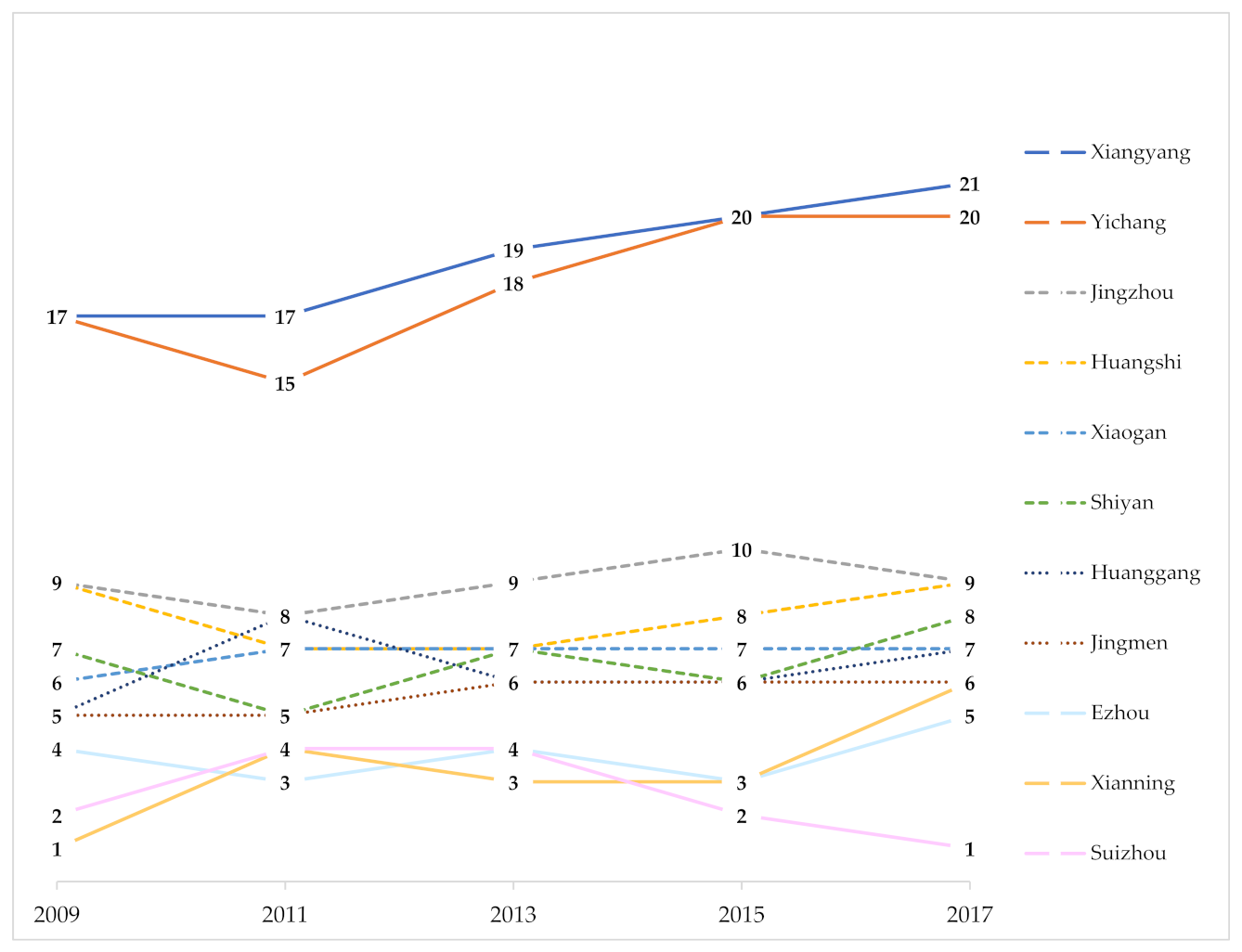
| First-Level Indicators | Second-Level Indicators | Index Interpretation | Code Name |
|---|---|---|---|
| Population C1 | Urban Resident Population | Urban size | C11 |
| economic strength C2 | GRP (gross regional product) | Economic aggregate | C21 |
| per capita GRP | Per capita economic development level | C22 | |
| Total value of industrial enterprises above scale | Industrial development level | C23 | |
| Total output value of the construction industry | Development level of construction industry | C24 | |
| Added value of the tertiary industry | Development level of tertiary industry | C25 | |
| Local general public budget income | Government strength | C26 | |
| Secondary industry as a percentage of GRP | Economic structure | C27 | |
| Tertiary industry as a percentage of GRP | Economic structure | C28 | |
| Infrastructure C3 | Investment in capital construction | Capital construction level | C31 |
| Total amount of post and telecommunications business | Communication frequency degree | C32 | |
| Area of paved roads in the city at year-end | Traffic levels | C33 | |
| Road area per capita | Urban traffic congestion degree | C34 | |
| Water supply | Energy supply | C35 | |
| Annual electricity consumption | Energy supply | C36 | |
| Number of beds in health institutions | Medical facilities | C37 | |
| Science, technology and culture C4 | Number of students in higher education institutions | Talents and education level | C41 |
| The amount of patent application accepted | Innovative ability | C42 | |
| The number of books collected in public libraries | Urban cultural level | C43 | |
| Added value of high-tech industry | Development level of scientific and technological innovation | C44 | |
| Open communication C5 | Total import and export volume | Foreign economy | C51 |
| Passenger traffic | Human flow | C52 | |
| Freight traffic | Material flow | C53 | |
| Domestic tourism earnings | Tourism attracts income | C54 | |
| International tourism foreign exchange earnings | Tourism attracts income | C55 | |
| The quality of life C6 | Per capita disposable income of permanent urban residents | Income | C61 |
| Per capita consumption expenditure of permanent urban residents | Expenditure | C62 | |
| Per capita housing area in urban | Living comfort | C63 | |
| Retail sales of consumer goods | Consumption level | C64 | |
| Green coverage area as a percentage of built-up areas | Quality of environment | C65 |
| 2009 | Order | 2011 | Order | 2013 | Order | 2015 | Order | 2017 | Order | ||
|---|---|---|---|---|---|---|---|---|---|---|---|
| C1 | C11 | 0.0294 | 19 | 0.0301 | 18 | 0.0312 | 17 | 0.0257 | 18 | 0.0251 | 18 |
| C2 | C21 | 0.0348 | 15 | 0.0357 | 13 | 0.0342 | 14 | 0.037 | 14 | 0.0391 | 11 |
| C22 | 0.0087 | 27 | 0.0089 | 29 | 0.01 | 29 | 0.0148 | 24 | 0.0179 | 25 | |
| C23 | 0.025 | 20 | 0.0194 | 21 | 0.0173 | 21 | 0.0326 | 16 | 0.0365 | 14 | |
| C24 | 0.0527 | 6 | 0.053 | 5 | 0.0473 | 6 | 0.0511 | 5 | 0.056 | 4 | |
| C25 | 0.0445 | 9 | 0.046 | 8 | 0.0465 | 8 | 0.0442 | 9 | 0.0487 | 7 | |
| C26 | 0.0664 | 2 | 0.0469 | 7 | 0.0464 | 9 | 0.0426 | 10 | 0.0448 | 9 | |
| C27 | 0.012 | 25 | 0.0177 | 22 | 0.0118 | 25 | 0.0092 | 29 | 0.0118 | 27 | |
| C28 | 0.0112 | 26 | 0.0105 | 27 | 0.0172 | 22 | 0.0174 | 22 | 0.0092 | 29 | |
| C3 | C31 | 0.034 | 16 | 0.0281 | 19 | 0.0224 | 20 | 0.024 | 19 | 0.0186 | 23 |
| C32 | 0.0319 | 18 | 0.0308 | 17 | 0.0443 | 10 | 0.0349 | 15 | 0.0457 | 8 | |
| C33 | 0.0374 | 12 | 0.0393 | 11 | 0.0429 | 11 | 0.0424 | 11 | 0.0387 | 13 | |
| C34 | 0.0214 | 21 | 0.0163 | 23 | 0.0243 | 19 | 0.0124 | 27 | 0.011 | 28 | |
| C35 | 0.046 | 7 | 0.057 | 4 | 0.0633 | 2 | 0.0593 | 3 | 0.0634 | 2 | |
| C36 | 0.0373 | 13 | 0.0375 | 12 | 0.0388 | 12 | 0.0392 | 12 | 0.022 | 20 | |
| C37 | 0.0202 | 22 | 0.0203 | 20 | 0.0162 | 23 | 0.0161 | 23 | 0.018 | 24 | |
| C4 | C41 | 0.0607 | 4 | 0.0593 | 3 | 0.0578 | 4 | 0.0558 | 4 | 0.0596 | 3 |
| C42 | 0.0415 | 10 | 0.0422 | 9 | 0.0466 | 7 | 0.0459 | 7 | 0.0407 | 10 | |
| C43 | 0.0554 | 5 | 0.0418 | 10 | 0.0372 | 13 | 0.0387 | 13 | 0.0237 | 19 | |
| C44 | 0.0391 | 11 | 0.033 | 16 | 0.0333 | 15 | 0.0485 | 6 | 0.0493 | 6 | |
| C5 | C51 | 0.0614 | 3 | 0.0722 | 2 | 0.0592 | 3 | 0.0609 | 2 | 0.0538 | 5 |
| C52 | 0.0139 | 23 | 0.0147 | 24 | 0.0149 | 24 | 0.0223 | 21 | 0.0252 | 17 | |
| C53 | 0.0358 | 14 | 0.0349 | 14 | 0.0294 | 18 | 0.0226 | 20 | 0.0271 | 16 | |
| C54 | 0.0452 | 8 | 0.0497 | 6 | 0.0517 | 5 | 0.0443 | 8 | 0.039 | 12 | |
| C55 | 0.0723 | 1 | 0.0746 | 1 | 0.0797 | 1 | 0.0798 | 1 | 0.0811 | 1 | |
| C6 | C61 | 0.0033 | 30 | 0.0101 | 28 | 0.0099 | 30 | 0.0142 | 26 | 0.0205 | 21 |
| C62 | 0.0044 | 29 | 0.0135 | 26 | 0.0104 | 28 | 0.0146 | 25 | 0.0204 | 22 | |
| C63 | 0.0078 | 28 | 0.0142 | 25 | 0.0112 | 27 | 0.0081 | 30 | 0.0137 | 26 | |
| C64 | 0.0324 | 17 | 0.0337 | 15 | 0.0328 | 16 | 0.0321 | 17 | 0.0326 | 15 | |
| C65 | 0.0137 | 24 | 0.0087 | 30 | 0.0117 | 26 | 0.0094 | 28 | 0.0068 | 30 |
| 2009 | Order | 2011 | Order | 2013 | Order | 2015 | Order | 2017 | Order | |
|---|---|---|---|---|---|---|---|---|---|---|
| population | 0.1259 | 5 | 0.1277 | 5 | 0.1371 | 5 | 0.1197 | 5 | 0.1238 | 5 |
| economic strength | 0.1951 | 3 | 0.1666 | 3 | 0.2104 | 2 | 0.2118 | 1 | 0.1993 | 3 |
| infrastructure | 0.1694 | 4 | 0.1376 | 4 | 0.1596 | 4 | 0.1656 | 4 | 0.1542 | 4 |
| sci-tech and culture | 0.2529 | 1 | 0.2341 | 1 | 0.2212 | 1 | 0.2057 | 2 | 0.2088 | 2 |
| open communication | 0.1992 | 2 | 0.2088 | 2 | 0.2015 | 3 | 0.2024 | 3 | 0.2161 | 1 |
| quality of life | 0.0575 | 6 | 0.1252 | 6 | 0.0701 | 6 | 0.0947 | 6 | 0.0978 | 6 |
| Level | Weight | Influence Degree | Indicators | ||||||||
|---|---|---|---|---|---|---|---|---|---|---|---|
| 1 | <0.016 | Weak | C22 | C27 | C28 | C61 | C62 | C63 | C65 | ||
| 2 | 0.016–0.034 | Sub-weak | C11 | C23 | C31 | C34 | C37 | C52 | C53 | C64 | |
| 3 | 0.034–0.046 | Sub-strong | C21 | C25 | C32 | C33 | C36 | C42 | C43 | C44 | C54 |
| 4 | >0.046 | Strong | C24 | C26 | C35 | C41 | C51 | C55 | |||
| City | 2009 | 2011 | 2013 | 2015 | 2017 | Average |
|---|---|---|---|---|---|---|
| Wuhan | 100 | 100 | 100 | 100 | 100 | 100 |
| Xiangyang | 17 | 17 | 19 | 20 | 21 | 18.8 |
| Yichang | 17 | 15 | 18 | 20 | 20 | 18 |
| Jingzhou | 9 | 8 | 9 | 10 | 9 | 9 |
| Huangshi | 9 | 7 | 7 | 8 | 9 | 8 |
| Xiaogan | 6 | 7 | 7 | 7 | 7 | 6.8 |
| Shiyan | 7 | 5 | 7 | 6 | 8 | 6.6 |
| Huanggang | 5 | 8 | 6 | 6 | 7 | 6.4 |
| Jingmen | 5 | 5 | 6 | 6 | 6 | 5.6 |
| Ezhou | 4 | 3 | 4 | 3 | 5 | 3.8 |
| Xianning | 1 | 4 | 3 | 3 | 6 | 3.4 |
| Suizhou | 2 | 4 | 4 | 2 | 1 | 2.6 |
Publisher’s Note: MDPI stays neutral with regard to jurisdictional claims in published maps and institutional affiliations. |
© 2022 by the authors. Licensee MDPI, Basel, Switzerland. This article is an open access article distributed under the terms and conditions of the Creative Commons Attribution (CC BY) license (https://creativecommons.org/licenses/by/4.0/).
Share and Cite
Ye, X.; Fan, Y.; Miao, J.; He, Z. The Competitiveness of Regional Urban System in Hubei Province of China. Land 2022, 11, 879. https://doi.org/10.3390/land11060879
Ye X, Fan Y, Miao J, He Z. The Competitiveness of Regional Urban System in Hubei Province of China. Land. 2022; 11(6):879. https://doi.org/10.3390/land11060879
Chicago/Turabian StyleYe, Xiaoxiao, Yong Fan, Jing Miao, and Zongyi He. 2022. "The Competitiveness of Regional Urban System in Hubei Province of China" Land 11, no. 6: 879. https://doi.org/10.3390/land11060879
APA StyleYe, X., Fan, Y., Miao, J., & He, Z. (2022). The Competitiveness of Regional Urban System in Hubei Province of China. Land, 11(6), 879. https://doi.org/10.3390/land11060879






